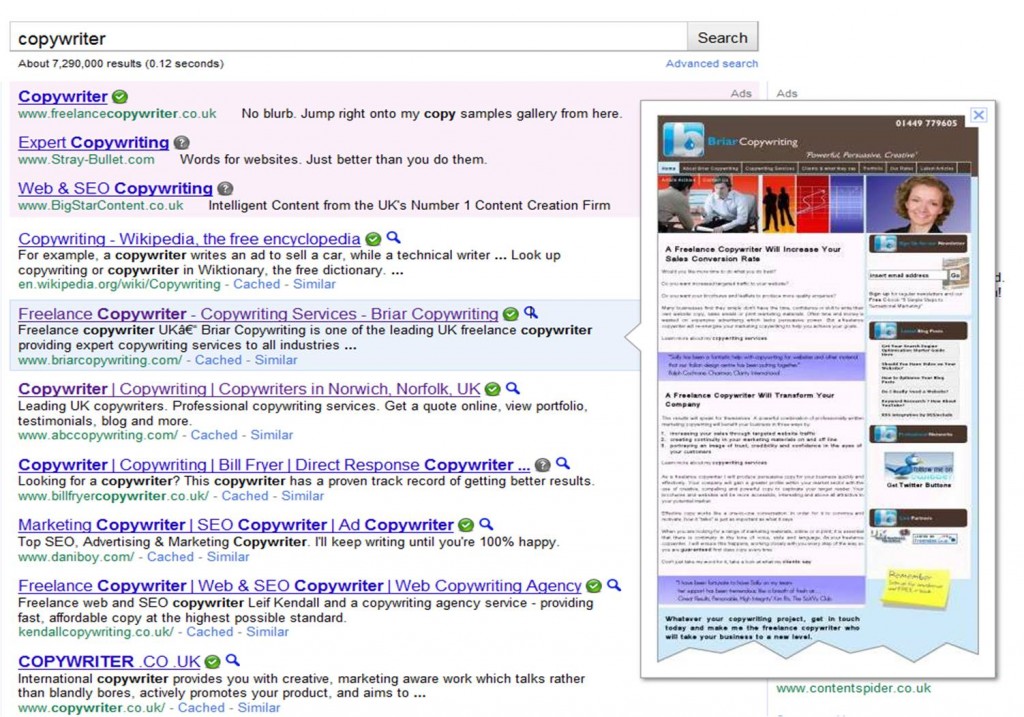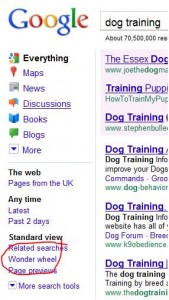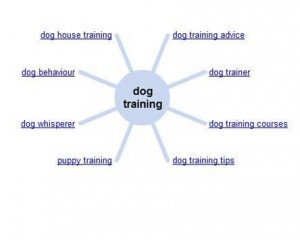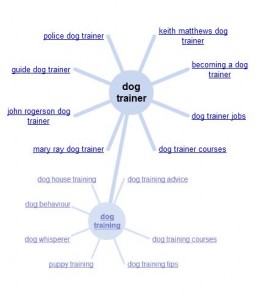Entries Tagged 'search engine optimisation' ↓
December 22nd, 2010 — blog, blogging, blogging for business, copywriter, search engine optimisation

If you use WordPress as your blogging platform you probably are already familiar with the All In One SEO Pack Plugin.
It’s a handy little tool to help you boost your blog posts’ SEO capabilities.
The only problem with it is that, although you may have already downloaded it into your blog, you probably haven’t really got to grips with using it.
It’s a bit like paying for yoru gym membership but never going – you’re not going to get fit. If you have it but don’t use it, your posts and blog may not be optimised to their maximum potential.
To help you out I found this post on seohosting.com which looks at What you can do with the all in one SEO pack plugin for WordPress?
It’s well worth a read and could help you blog better and smarter.
November 24th, 2010 — copywriter, freelance copywriter, freelance copywriting, Google Instant Preview, search engine optimisation
Things are changing in Google’s house once more.
If you are a regular user of the search engine you may have noticed its latest offering—Google Instant Preview.
As shown here, along side your search results are little magnifying glasses. By clicking on one a pop up appears showing a ‘preview’ of the website so you can check it out before clicking on the actual link for the site.

It’s designed to help the user save time by taking a peak at what the website offers before committing to that ultimate click.
But how does it affect the website owner and their search engine optimisation strategy?
The short answer is no one really knows yet—time will give us more of an insight into how it affects searching habits. But there are a few things you can do to maximise the chances of your website being chosen.
Banish flash
You already know that flash isn’t great for SEO. The search engine spiders have a tough time crawling through it and are unable to distinguish between normal text and that within header tags. But the added complication with flash is that it doesn’t do anything for your Google Instant Preview. This is because the Preview can’t render the flash element leaving your website looking distorted. So, if you want your website to look its best, you’d best ditch the flash.
META Descriptions
We all know that your META Description doesn’t have a direct effect on your SEO as far as ranking position goes, but it does as far as attracting that all important click goes.
The 150 characters within your META Description have to convince the reader your website is worth checking out. So if you want them to click your link or Preview magnifying glass, you must make every single word count.
Header tags
As you can see from the image above it’s not easy to make out the body text on the preview. But what are readable are the headings. Therefore the reader is going to base their decision on whether to click on your link or not, on the layout, headings and styling of your page—so you’d better make sure your headings are relevant and the look is just right.
Images and Alt tags
The images you use on your website are there to lure your reader so to give your SEO as much chance as possible make sure their filenames and Alt tags are descriptive, relevant and contain your keywords.
So whether you’re a copywriter, electrician, solicitor or builder these are 4 very simple techniques you can use to boost your website’s chances of receiving that coveted click.
November 17th, 2010 — copywriter, copywriting tips, search engine optimisation, seo, SEO copywriter

I have written several posts in the past about the importance of search engine optimisation. For a newcomer to SEO arena there’s a lot to take in:
- Keywords
- Alt tags
- Header tags
- Title tags
- META descriptions
- Links
It can be very daunting trying to get to grips with what each of these terms mean, how to find the keywords your target audience are searching for and that’s even before you get round to thinking about how to produce SEO Copywriting that works, is relevant and interesting to your reader.
Have you got a headache yet?
So how can a complete beginner start to grasp the basics of SEO?
Well I could write an extremely long post about the intricacies of each elements but that would be boring and you’re unlikely to have the time to wade through it all. But, as it would just so happen, I stumbled across a superb post by Mike Mindel of WordTracker that takes you through all the main elements in a very simple-to-understand way.
In previous posts you would have seen me refer to Google’s keyword tool, well WordTracker is a similar tool to help you easily research and discover the keywords you need to target. It is a pay-to-use tool but you can try it out for free with their 7 day risk free trial. Check it out, it’s well worth it.
Anyway, back to the really important stuff. Mike has put together a video that runs through the basics of how to SEO your web pages. It explains in simple language how to find your keywords and how to use them in your title tags, META descriptions, heading tags and image tags as well as the importance of using diverse keywords and linking.
It’s about 19 minutes in length so grab a coffee, sit down and take a look by clicking the button below. It could be your first step to great rankings.

November 5th, 2010 — copywriter, freelance copywriter, internet marketing, search engine optimisation, seo

As a freelance copywriter about 95% of my marketing activties are carried out online. Therefore I have had to learn the intricacies of search engine optimisation fairly quickly to gain front page rankings to ensure my business (Briar Copywriting) is visible to potential clients.
But it has taken a number of years and a lot of reading and research to really get to grips with the techniques.
What would you say if I told you there was a definitive guide to SEO available right now?
Yes please!
Well, there is. Google has just released its SEO Starter Guide (am updated version of their 2008 publication). Now before you get over excited let me add this disclaimer:
This guide will not give away secrets that will propel your website to the number one spot in the search results. But it will help you tweak your website to help you gain better visibility to the search engines as well as help you understand the mysteries of SEO.
So, if you’d like to get your hands on this valuable document click on the link below to download your free copy.

November 1st, 2010 — blog, blogging for business, copywriter, online marketing, search engine optimisation
If you follow this blog regularly you’ll know I’m a huge fan of blogging as a way of boosting your online presence. As a copywriter I’ve been using this method for several years now and it works.
Through the power of blogging you have the potential of driving a huge amount of traffic to your main sales site as part of your search engine optimisation strategy.
In an earlier post I looked at how to give your blogs eternal life, well now I want to expand on that theme by talking about how you can optimise each of your blog posts.
Below are 5 tips to help you get the most out of your blog posts through optimisation.
1. Quality content
There is no getting away from the fact that people only want to read well written, informative blog posts.
You must therefore create posts that are easy to read, interesting and informative. If there is value in your content your readers will share it with others. Not only that, it will also attract those all important back links.
2. Keywords
Because you are writing for an online audience you must take care to work out which keywords your post should be targeting. Once you’ve written your post, read it and think about what terms would your reader use to search for it. The primary keywords tend to be quite obvious, but other terms are not so clear-cut.
There are various tools you can use to identify your keywords such as Google’s keyword tool. But there are also a few other tools you can use that will help you identify terms associate with your primary keyword. One is the Google Tilde search. But there is also another more visual tool you can use.
Let me introduce you to the Google Wheel. When you’ve entered your search term into the Google search box, if you look to the left of your screen you’ll see Wonder Wheel.

If you click on this it will produce a wheel diagram with your main search term in the centre (in this case ‘dog training’) with associated terms around it:

You can then click on any other outer terms to receive further results:

3. META Titles and descriptions
This is one aspect that is often forgotten. The META title and description are there to tell both the reader and search engine spiders what your posts is about. If you use the WordPress.com platform for your blog you can use the All in one SEO Pack to specify these fields.
When writing your titles and descriptions make sure your keywords are near the beginning. There is also a character limit for each (Titles – 72, Description – 165) so you’ll have to carefully plan your words.
4. Links
Both internal and external links are important when writing your posts. As you can see, I’ve used a mixture of both.
Your internal links (utilising related keywords) link out to other posts, while external links take the reader to other related websites. In both cases make sure you use keyword rich links rather than something like ‘click here’ which has no value.
Your external links can also be used to encourage inbound links from other websites as ‘trackbacks’ inform that web owner you have linked to them. Therefore they may in turn link to your posts.
5. URL
The last item on my list is your URL. This I the web address used to link to your post. Make sure you use your keywords within this as it will instantly show the relevance of your post.
Make sure it is meaningful.
By utilising each of these techniques and tools, you will produce meaningful, interesting blog posts that will be found through the search engines. Not only that, but by ensuring you create quality content you will attract links and build your reputation as an expert in your field.
Blogging is an excellent way of getting your voice heard.














